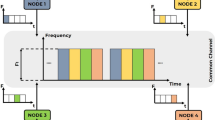Abstract
The challenge of next generation mobile wireless networks necessitates efficient usage of available spectrum. The multiple input multiple output (MIMO)–orthogonal frequency division multiple access (OFDMA) technology exploits spatial and frequency diversity completely to maximize the usage of the limited available spectrum. The major factor that MIMO–OFDMA system proposes is allocation of interference free blocks for the arriving traffic. The author extends subsequence DPA strategy to MIMO–OFDMA system to transmit real time video traffic. The traffic and channel interference constraints are considered. The system is modeled using generalized stochastic petri nets and the analytical results are validated by simulation. The performance characteristics like mean delay and normalized throughput of subsequence DPA for various combinations are analysed. For 4 × 4 system, subsequence DPA (1, 4) and (2, 2) combinations are analyzed and it is observed that (2, 2) combination performs well than that of (1, 4) combination by 33 and 32% in terms of mean delay and normalized throughput respectively. For 8 × 8 system, subsequence DPA for (1, 8), (2, 4) and (4, 2) combinations are examined and (2, 4) and (4, 2) outperforms (1, 8) by 51 and 75% respectively in terms of mean delay and 48 and 74% respectively for normalized throughput.












Similar content being viewed by others
References
Verde, F., Darsen, D., & Scalione, A. (2010). Cooperative randomized MIMO–OFDM downlink for multicell networks: Design and analysis. IEEE Transactions on Signal Processsing, 58(1), 384–402.
Pirak, C., Wang, Z. J., Liu, K. J. R., & Jitapunkul, S. (2006). Adaptive channel estimation using pilot-embedded data-bearing approach for MIMO–OFDM systems. IEEE Transactions on Signal Processing, 54(12), 4706–4716.
Su, W., Safar, Z., Olfat, M., & Liu, K. J. R. (2003). Obtaining full diversity space–frequency codes and space–time codes via mapping. IEEE Transactions on Signal Processing, 51(11), 2905–2916.
Paul, T., & Ogunfunmi, T. (2008). Wireless LAN comes of age: Understanding the IEEE 82.11n amendment. IEEE Circuits Systems Magazine, 8(1), 28–54.
Yeh, S.-Y., Liao, Y.-T., Lai, W.-C., & Hsu, T.-Y. (2014). Cost-efficient frequency-domain MIMO–OFDM modem with an SIMD ALU-based architecture. IEEE Transactions on Very Large Scale Integration Systems, 99, 1–13.
Biagioni, A., Fantacci, R., Marabissi, D., & Tarchi, D. (2009). Adaptive subcarrier allocation schemes for wireless OFDMA system in WiMAX networks. IEEE Journal on Selected Areas in Communication, 27(2), 217–225.
Li, F., Ren, P., & Qinghe, D. (2012). Joint packet scheduling and subcarrier assignment for video communications over downlink OFDMA systems. IEEE Transactions on Vehicular Technology, 61(6), 2753–2767.
Benita, J., & Jayaparvathy, R. (2015). Comparative performance analysis of subcarrier assignment for real time video traffic. IET Networks, 4(6), 304–313.
Jayaparvathy, R., Anand, S., Dharmaraja, S., & Srikanth, S. (2006). Performance analysis of IEEE 802.11 DCF with stochastic reward nets. International Journal of Communication Systems, 20, 273–296.
Geetha, S., & Jayaparvathy, R. (2010). Generalized stochastic petri net approach to model bandwidth allocation in IEEE 80220 MAC. ICGST-CNIR Journal, 10(1), 67–76.
Song, W., & Zhuang, W. (2012). Performance analysis of probabilistic multipath transmission of video streaming traffic over multi-radio wireless devices. IEEE Transactions on Wireless Communications, 11(4), 1554–1564.
Kleinrock, L. (1995). Queuing systems: Volume I. Theory. Dordrecht: Kluwer Academic Press.
Gallager, R., & Bertsekas, D. (1992). Data networks. Englewood Cliffs: Prentice Hall.
Author information
Authors and Affiliations
Corresponding author
Appendix
Appendix
The complexity of the CTMC underlying the GSPN model in Fig. 4, can be found if the number of states in the CTMC is calculated. The GSPN model has 12 places and hence the CTMC can have 12 dimensions.
Let m represent the number of tokens in place p
-
1.
At any time t, the number of tokens in place TR_BUF is less than or equal to the number of transmissions considered. Let \(m_{TR\_BUF} \, \le\, k\) where k represent the average number of transmissions. Thus, the number of possible states of TR_BUF is (k + 1).
-
2.
The places TX_BUF_SEQ1, TX_BUF_SEQ2, RX_BUF_SEQ1 and RX_BUF_SEQ2 represent either the presence of a token which indicates a sequence waiting for fragmentation provided required numbers of feasible blocks are available. Or absence of a token indicates an ongoing transmission. Thus there are only 2 states, 0 or 1. Total number of states is 2 × 4 = 8.
-
3.
The places TX_SUB_SEQ1, TX_SUB_SEQ2, TX_SUB_SEQ3 and TX_SUB_SEQ4 holds no token or m tokens. m is the maximum number of tokens a block an carry at ant time t the total number of states of a single place is 2. The number of place is always twice the number of places in step 2. Thus total number of states of all the above said places are 2 × 4 = 8
-
4.
A token in RX represents a successful reception of a video sequence. The number of tokens increases from 0 to l, where l (< m) indicates the successfully received video sequences. The number of states of RX is (l + 1).
-
5.
SUBCAR_POOL is the place that denotes the total number of available subcarriers in the base station. Let the total number of subcarriers is denoted by capacity. Then the total number of states is (capacity + 1).
-
6.
The places FEA_BLK will be deposited by a token when a subcarrier block becomes a feasible block. That is, the interference in the block is less than a pre determined threshold, ε. Let ‘n’ be the number of blocks feasible at any time t, then the number of states of FEA_BLK is given by (n + 1).
Thus from the above discussion, at any time t, the total number of states of the GSPN given by Fig. 4 is
Assume k = 2, l = 1, capacity = 1200 and n = 12, then \(total_{states} \approx 691 ,200\). The CTMC is more complex if the number of video sequences or number of antenna or number of subcarriers in the system increases. Hence to model the underlying CTMC of the GSPN, TimeNET modeling tool is used.
Rights and permissions
About this article
Cite this article
Benita, J., Jayaparvathy, R. Block Allocation Strategy for Multiple Input Multiple Output (MIMO)–Orthogonal Frequency Division Multiple Access (OFDMA) System. Wireless Pers Commun 101, 1201–1219 (2018). https://doi.org/10.1007/s11277-018-5641-5
Published:
Issue Date:
DOI: https://doi.org/10.1007/s11277-018-5641-5




